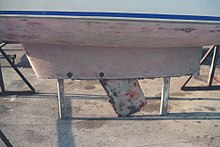Keel sword
A keel sword is the combination of ballast keel and sword in sailing boats , which gives stability against both drift and heel .
From a certain size / sail area, a modern sailing boat usually has a fin keel , the weight of which allows it to travel as upright as possible and is intended to prevent the boat from drifting in the water as a lateral resistance . The disadvantage is the resulting depth. A large part of the water surface in the inland area and also in the Bodden waters becomes impassable for these boats. That's why dinghies have a retractable sword , which, however, does not provide any static stability due to the lack of weight .
A keel (centerboard) is a compromise. Keel structures are a combination of a ballast keel with a retractable sword. The ballast keel takes over the ballast function of the keel and the sword reduces drift. This enables a variable draft and thus the approach to shallow waters without drifting (much) more than keelboats. A boat with a keel sword is called a keel sword .
The sword is in the recovered state in the middle of the (stub) keel. It is rotatably mounted in the front area and is usually supported by a line (sword case) z. B. held up in the cockpit . By lowering the sword case, the sword is extended due to its own weight. This construction is no longer in use today because it is extremely prone to failure. Foreign objects can jam the sword. In addition, wear and rust at the pivot point very soon create free spaces that make the sword rattle in the keel and thus cause additional signs of wear and tear.
The sword halyard should always be kept on pull, even when it is lowered. There is a risk that the sword fall will be pulled out of the cockpit by the jerky ship movements in the shaft. Even knots that are supposed to prevent this can be pulled through by the force of these jerking movements, and in the worst case they become wedged and make catching up impossible. If the sword fall loosens in shallow water and the lowered sword is loaded by touching the ground and drifting sideways, it can bend. If this is suspected, it should not be caught up, as it could possibly get stuck in the keel if caught up. The close-hauled sailing characteristics with the fetched sword deteriorate significantly.
Other solutions provide a swing keel or a lifting keel .
